Individual Case Study Analysis Report - Equity and Executive Pay
VerifiedAdded on 2023/01/18
|8
|2042
|44
Case Study
AI Summary
This case study delves into the contentious issue of equity and executive pay, specifically the significant pay disparity between chief executive officers (CEOs) and other employees. The analysis explores the application of equity theory in determining compensation, highlighting the advantages and disadvantages of this approach. It examines the use of market-based comparisons in setting executive compensation and the potential for this to be considered 'fair'. The study presents various options to address the pay gap, including performance-based compensation, procedural justice, and government regulation. Furthermore, the report provides practical recommendations to promote fairer pay practices, such as capping executive salaries, investing in employee learning and development, increasing salary transparency, and considering a luxury tax on excessive executive pay. The report aims to provide insights into the complexities of executive compensation and suggest strategies for more equitable practices.
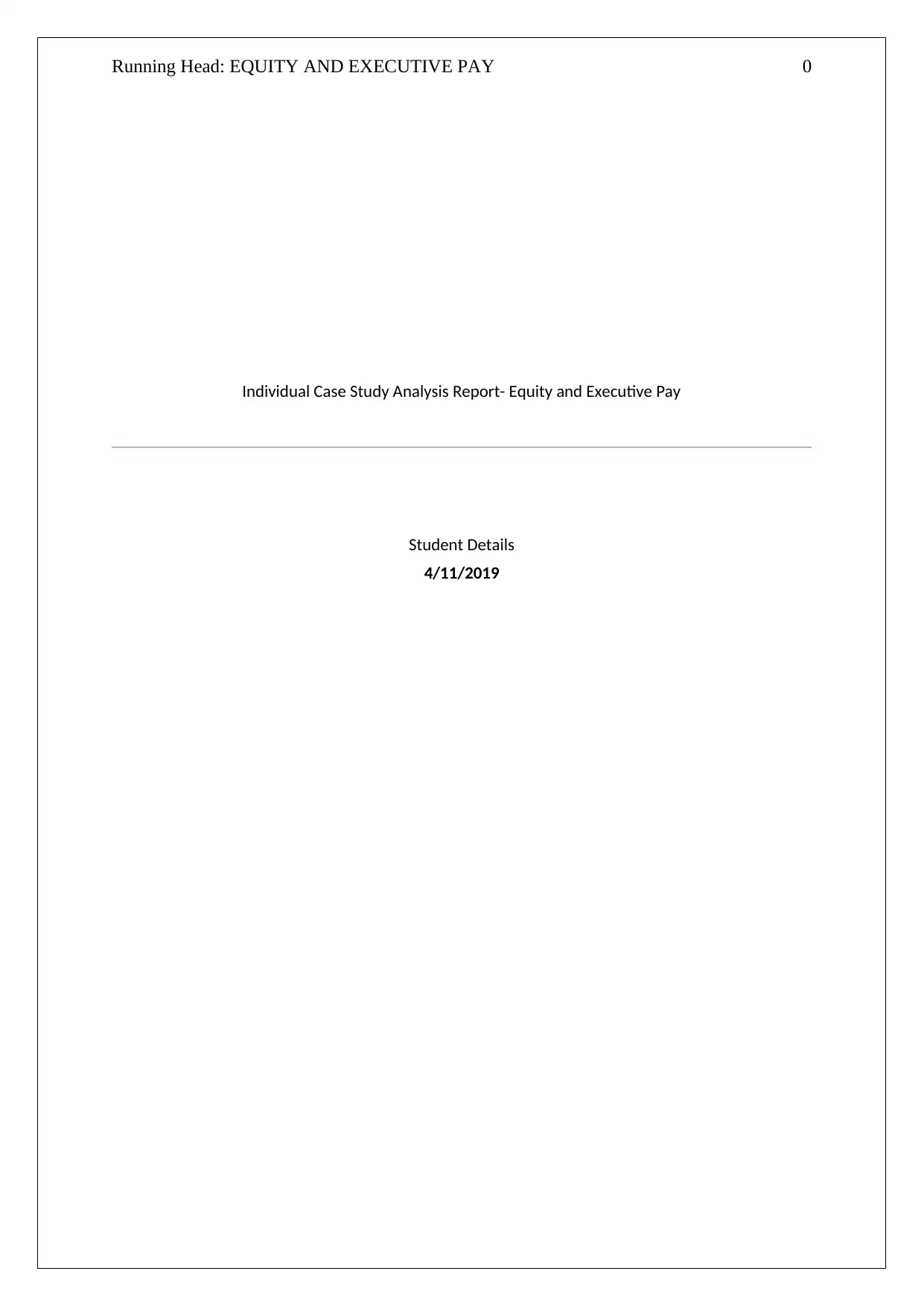
Running Head: EQUITY AND EXECUTIVE PAY 0
Individual Case Study Analysis Report- Equity and Executive Pay
Student Details
4/11/2019
Individual Case Study Analysis Report- Equity and Executive Pay
Student Details
4/11/2019
Paraphrase This Document
Need a fresh take? Get an instant paraphrase of this document with our AI Paraphraser

Equity and Executive Pay 1
Contents
Summary....................................................................................................................................2
Advantages.................................................................................................................................2
Disadvantages............................................................................................................................2
Options.......................................................................................................................................3
Recommendations......................................................................................................................3
References..................................................................................................................................5
Contents
Summary....................................................................................................................................2
Advantages.................................................................................................................................2
Disadvantages............................................................................................................................2
Options.......................................................................................................................................3
Recommendations......................................................................................................................3
References..................................................................................................................................5
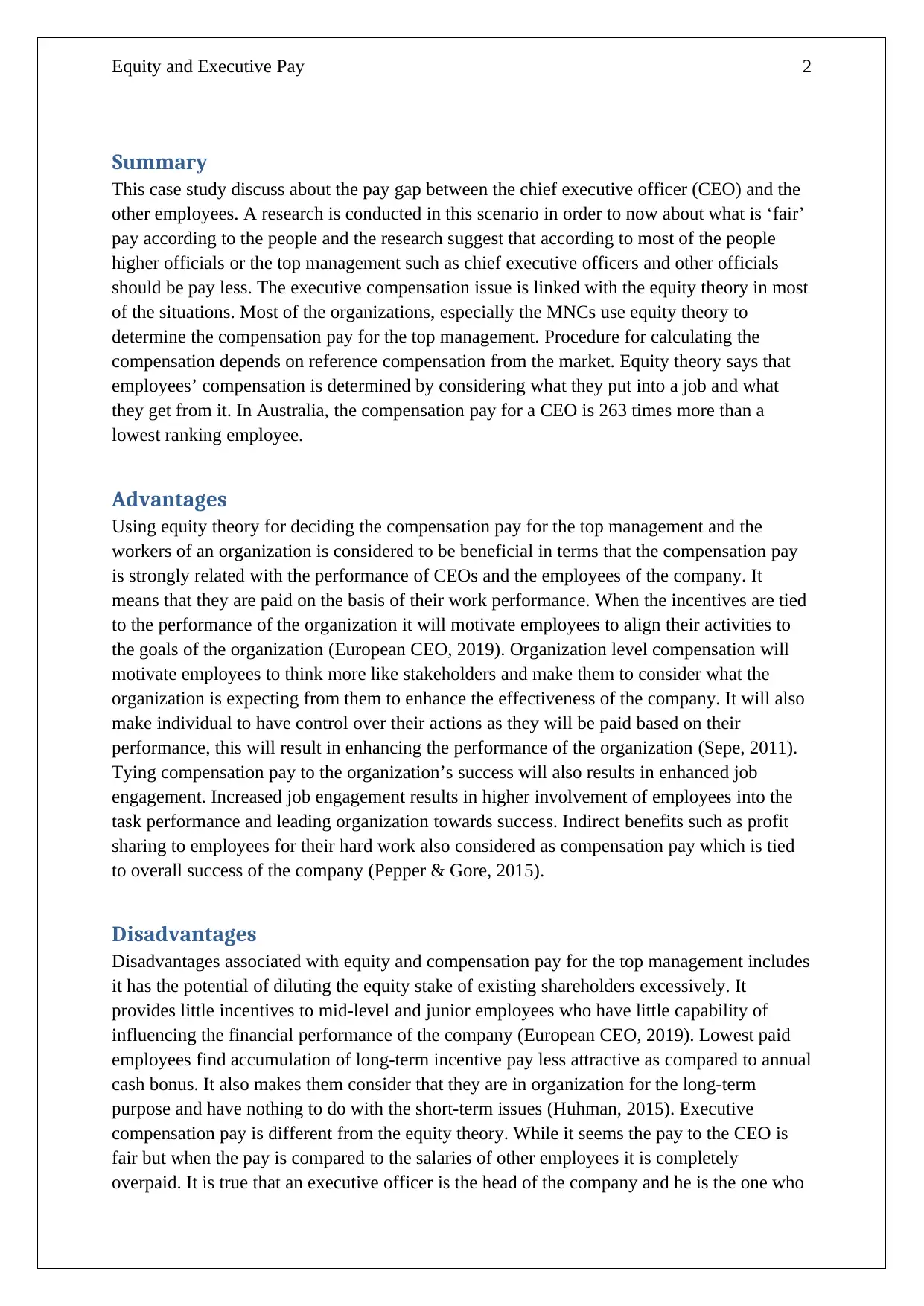
Equity and Executive Pay 2
Summary
This case study discuss about the pay gap between the chief executive officer (CEO) and the
other employees. A research is conducted in this scenario in order to now about what is ‘fair’
pay according to the people and the research suggest that according to most of the people
higher officials or the top management such as chief executive officers and other officials
should be pay less. The executive compensation issue is linked with the equity theory in most
of the situations. Most of the organizations, especially the MNCs use equity theory to
determine the compensation pay for the top management. Procedure for calculating the
compensation depends on reference compensation from the market. Equity theory says that
employees’ compensation is determined by considering what they put into a job and what
they get from it. In Australia, the compensation pay for a CEO is 263 times more than a
lowest ranking employee.
Advantages
Using equity theory for deciding the compensation pay for the top management and the
workers of an organization is considered to be beneficial in terms that the compensation pay
is strongly related with the performance of CEOs and the employees of the company. It
means that they are paid on the basis of their work performance. When the incentives are tied
to the performance of the organization it will motivate employees to align their activities to
the goals of the organization (European CEO, 2019). Organization level compensation will
motivate employees to think more like stakeholders and make them to consider what the
organization is expecting from them to enhance the effectiveness of the company. It will also
make individual to have control over their actions as they will be paid based on their
performance, this will result in enhancing the performance of the organization (Sepe, 2011).
Tying compensation pay to the organization’s success will also results in enhanced job
engagement. Increased job engagement results in higher involvement of employees into the
task performance and leading organization towards success. Indirect benefits such as profit
sharing to employees for their hard work also considered as compensation pay which is tied
to overall success of the company (Pepper & Gore, 2015).
Disadvantages
Disadvantages associated with equity and compensation pay for the top management includes
it has the potential of diluting the equity stake of existing shareholders excessively. It
provides little incentives to mid-level and junior employees who have little capability of
influencing the financial performance of the company (European CEO, 2019). Lowest paid
employees find accumulation of long-term incentive pay less attractive as compared to annual
cash bonus. It also makes them consider that they are in organization for the long-term
purpose and have nothing to do with the short-term issues (Huhman, 2015). Executive
compensation pay is different from the equity theory. While it seems the pay to the CEO is
fair but when the pay is compared to the salaries of other employees it is completely
overpaid. It is true that an executive officer is the head of the company and he is the one who
Summary
This case study discuss about the pay gap between the chief executive officer (CEO) and the
other employees. A research is conducted in this scenario in order to now about what is ‘fair’
pay according to the people and the research suggest that according to most of the people
higher officials or the top management such as chief executive officers and other officials
should be pay less. The executive compensation issue is linked with the equity theory in most
of the situations. Most of the organizations, especially the MNCs use equity theory to
determine the compensation pay for the top management. Procedure for calculating the
compensation depends on reference compensation from the market. Equity theory says that
employees’ compensation is determined by considering what they put into a job and what
they get from it. In Australia, the compensation pay for a CEO is 263 times more than a
lowest ranking employee.
Advantages
Using equity theory for deciding the compensation pay for the top management and the
workers of an organization is considered to be beneficial in terms that the compensation pay
is strongly related with the performance of CEOs and the employees of the company. It
means that they are paid on the basis of their work performance. When the incentives are tied
to the performance of the organization it will motivate employees to align their activities to
the goals of the organization (European CEO, 2019). Organization level compensation will
motivate employees to think more like stakeholders and make them to consider what the
organization is expecting from them to enhance the effectiveness of the company. It will also
make individual to have control over their actions as they will be paid based on their
performance, this will result in enhancing the performance of the organization (Sepe, 2011).
Tying compensation pay to the organization’s success will also results in enhanced job
engagement. Increased job engagement results in higher involvement of employees into the
task performance and leading organization towards success. Indirect benefits such as profit
sharing to employees for their hard work also considered as compensation pay which is tied
to overall success of the company (Pepper & Gore, 2015).
Disadvantages
Disadvantages associated with equity and compensation pay for the top management includes
it has the potential of diluting the equity stake of existing shareholders excessively. It
provides little incentives to mid-level and junior employees who have little capability of
influencing the financial performance of the company (European CEO, 2019). Lowest paid
employees find accumulation of long-term incentive pay less attractive as compared to annual
cash bonus. It also makes them consider that they are in organization for the long-term
purpose and have nothing to do with the short-term issues (Huhman, 2015). Executive
compensation pay is different from the equity theory. While it seems the pay to the CEO is
fair but when the pay is compared to the salaries of other employees it is completely
overpaid. It is true that an executive officer is the head of the company and he is the one who
⊘ This is a preview!⊘
Do you want full access?
Subscribe today to unlock all pages.

Trusted by 1+ million students worldwide
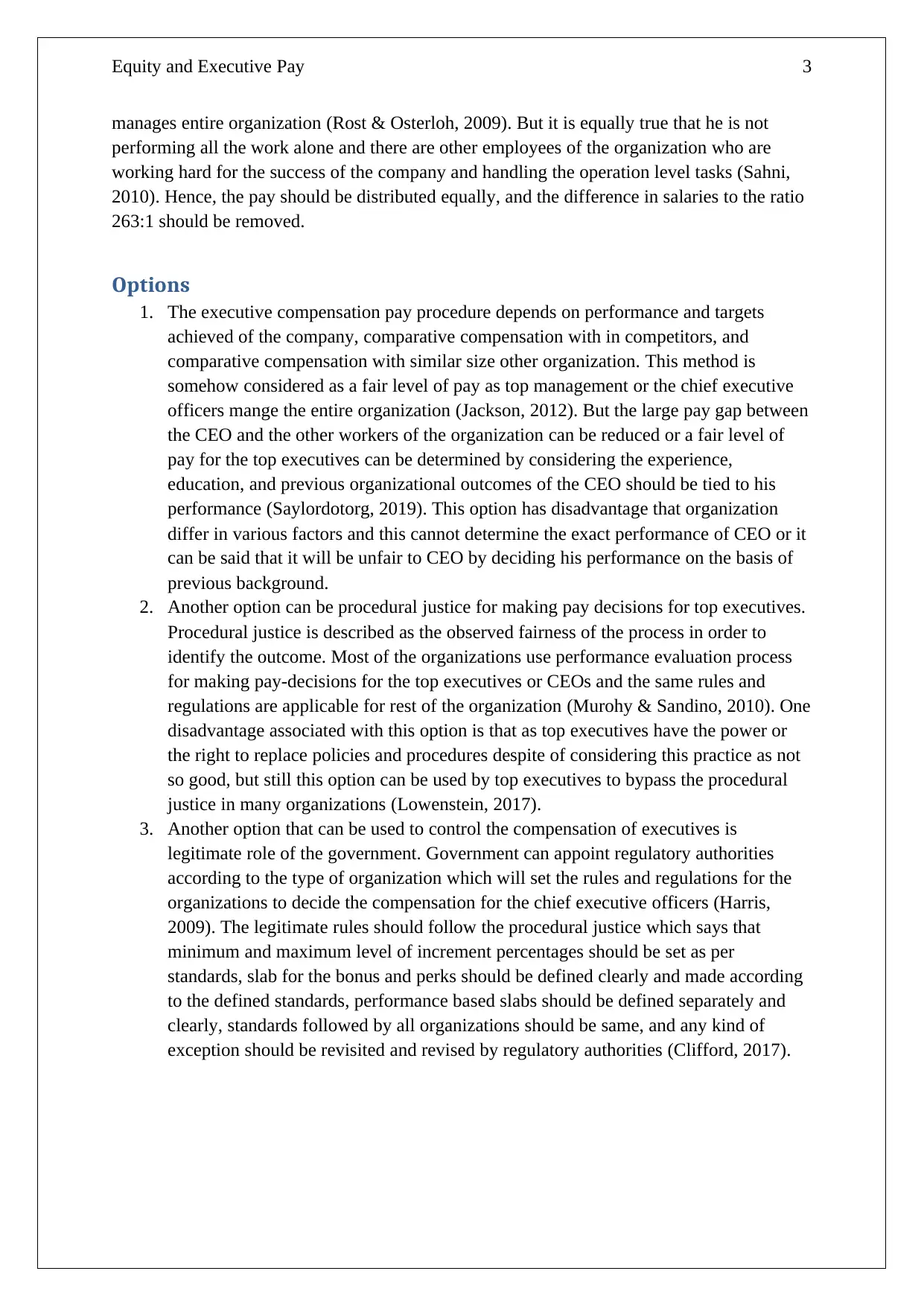
Equity and Executive Pay 3
manages entire organization (Rost & Osterloh, 2009). But it is equally true that he is not
performing all the work alone and there are other employees of the organization who are
working hard for the success of the company and handling the operation level tasks (Sahni,
2010). Hence, the pay should be distributed equally, and the difference in salaries to the ratio
263:1 should be removed.
Options
1. The executive compensation pay procedure depends on performance and targets
achieved of the company, comparative compensation with in competitors, and
comparative compensation with similar size other organization. This method is
somehow considered as a fair level of pay as top management or the chief executive
officers mange the entire organization (Jackson, 2012). But the large pay gap between
the CEO and the other workers of the organization can be reduced or a fair level of
pay for the top executives can be determined by considering the experience,
education, and previous organizational outcomes of the CEO should be tied to his
performance (Saylordotorg, 2019). This option has disadvantage that organization
differ in various factors and this cannot determine the exact performance of CEO or it
can be said that it will be unfair to CEO by deciding his performance on the basis of
previous background.
2. Another option can be procedural justice for making pay decisions for top executives.
Procedural justice is described as the observed fairness of the process in order to
identify the outcome. Most of the organizations use performance evaluation process
for making pay-decisions for the top executives or CEOs and the same rules and
regulations are applicable for rest of the organization (Murohy & Sandino, 2010). One
disadvantage associated with this option is that as top executives have the power or
the right to replace policies and procedures despite of considering this practice as not
so good, but still this option can be used by top executives to bypass the procedural
justice in many organizations (Lowenstein, 2017).
3. Another option that can be used to control the compensation of executives is
legitimate role of the government. Government can appoint regulatory authorities
according to the type of organization which will set the rules and regulations for the
organizations to decide the compensation for the chief executive officers (Harris,
2009). The legitimate rules should follow the procedural justice which says that
minimum and maximum level of increment percentages should be set as per
standards, slab for the bonus and perks should be defined clearly and made according
to the defined standards, performance based slabs should be defined separately and
clearly, standards followed by all organizations should be same, and any kind of
exception should be revisited and revised by regulatory authorities (Clifford, 2017).
manages entire organization (Rost & Osterloh, 2009). But it is equally true that he is not
performing all the work alone and there are other employees of the organization who are
working hard for the success of the company and handling the operation level tasks (Sahni,
2010). Hence, the pay should be distributed equally, and the difference in salaries to the ratio
263:1 should be removed.
Options
1. The executive compensation pay procedure depends on performance and targets
achieved of the company, comparative compensation with in competitors, and
comparative compensation with similar size other organization. This method is
somehow considered as a fair level of pay as top management or the chief executive
officers mange the entire organization (Jackson, 2012). But the large pay gap between
the CEO and the other workers of the organization can be reduced or a fair level of
pay for the top executives can be determined by considering the experience,
education, and previous organizational outcomes of the CEO should be tied to his
performance (Saylordotorg, 2019). This option has disadvantage that organization
differ in various factors and this cannot determine the exact performance of CEO or it
can be said that it will be unfair to CEO by deciding his performance on the basis of
previous background.
2. Another option can be procedural justice for making pay decisions for top executives.
Procedural justice is described as the observed fairness of the process in order to
identify the outcome. Most of the organizations use performance evaluation process
for making pay-decisions for the top executives or CEOs and the same rules and
regulations are applicable for rest of the organization (Murohy & Sandino, 2010). One
disadvantage associated with this option is that as top executives have the power or
the right to replace policies and procedures despite of considering this practice as not
so good, but still this option can be used by top executives to bypass the procedural
justice in many organizations (Lowenstein, 2017).
3. Another option that can be used to control the compensation of executives is
legitimate role of the government. Government can appoint regulatory authorities
according to the type of organization which will set the rules and regulations for the
organizations to decide the compensation for the chief executive officers (Harris,
2009). The legitimate rules should follow the procedural justice which says that
minimum and maximum level of increment percentages should be set as per
standards, slab for the bonus and perks should be defined clearly and made according
to the defined standards, performance based slabs should be defined separately and
clearly, standards followed by all organizations should be same, and any kind of
exception should be revisited and revised by regulatory authorities (Clifford, 2017).
Paraphrase This Document
Need a fresh take? Get an instant paraphrase of this document with our AI Paraphraser
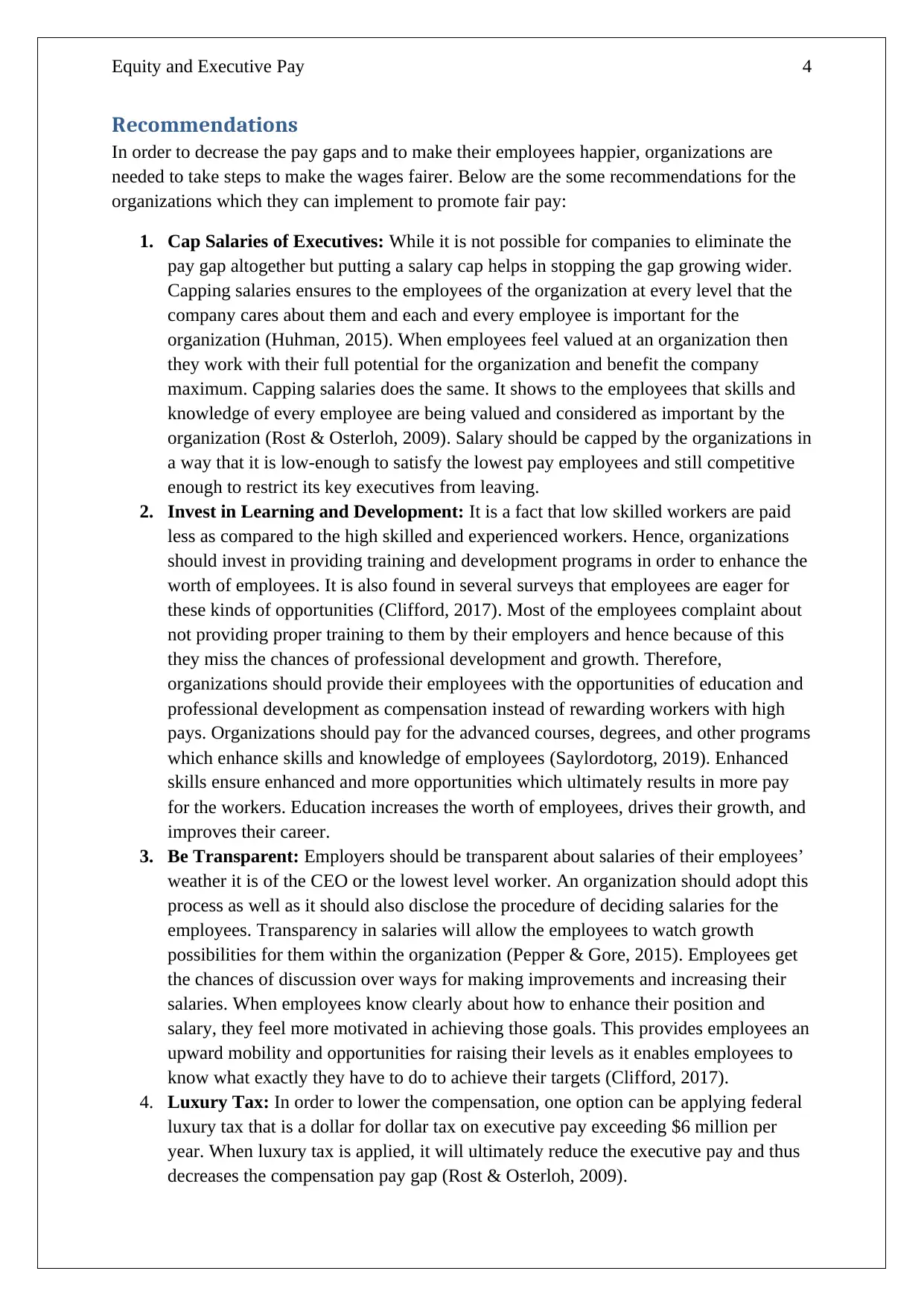
Equity and Executive Pay 4
Recommendations
In order to decrease the pay gaps and to make their employees happier, organizations are
needed to take steps to make the wages fairer. Below are the some recommendations for the
organizations which they can implement to promote fair pay:
1. Cap Salaries of Executives: While it is not possible for companies to eliminate the
pay gap altogether but putting a salary cap helps in stopping the gap growing wider.
Capping salaries ensures to the employees of the organization at every level that the
company cares about them and each and every employee is important for the
organization (Huhman, 2015). When employees feel valued at an organization then
they work with their full potential for the organization and benefit the company
maximum. Capping salaries does the same. It shows to the employees that skills and
knowledge of every employee are being valued and considered as important by the
organization (Rost & Osterloh, 2009). Salary should be capped by the organizations in
a way that it is low-enough to satisfy the lowest pay employees and still competitive
enough to restrict its key executives from leaving.
2. Invest in Learning and Development: It is a fact that low skilled workers are paid
less as compared to the high skilled and experienced workers. Hence, organizations
should invest in providing training and development programs in order to enhance the
worth of employees. It is also found in several surveys that employees are eager for
these kinds of opportunities (Clifford, 2017). Most of the employees complaint about
not providing proper training to them by their employers and hence because of this
they miss the chances of professional development and growth. Therefore,
organizations should provide their employees with the opportunities of education and
professional development as compensation instead of rewarding workers with high
pays. Organizations should pay for the advanced courses, degrees, and other programs
which enhance skills and knowledge of employees (Saylordotorg, 2019). Enhanced
skills ensure enhanced and more opportunities which ultimately results in more pay
for the workers. Education increases the worth of employees, drives their growth, and
improves their career.
3. Be Transparent: Employers should be transparent about salaries of their employees’
weather it is of the CEO or the lowest level worker. An organization should adopt this
process as well as it should also disclose the procedure of deciding salaries for the
employees. Transparency in salaries will allow the employees to watch growth
possibilities for them within the organization (Pepper & Gore, 2015). Employees get
the chances of discussion over ways for making improvements and increasing their
salaries. When employees know clearly about how to enhance their position and
salary, they feel more motivated in achieving those goals. This provides employees an
upward mobility and opportunities for raising their levels as it enables employees to
know what exactly they have to do to achieve their targets (Clifford, 2017).
4. Luxury Tax: In order to lower the compensation, one option can be applying federal
luxury tax that is a dollar for dollar tax on executive pay exceeding $6 million per
year. When luxury tax is applied, it will ultimately reduce the executive pay and thus
decreases the compensation pay gap (Rost & Osterloh, 2009).
Recommendations
In order to decrease the pay gaps and to make their employees happier, organizations are
needed to take steps to make the wages fairer. Below are the some recommendations for the
organizations which they can implement to promote fair pay:
1. Cap Salaries of Executives: While it is not possible for companies to eliminate the
pay gap altogether but putting a salary cap helps in stopping the gap growing wider.
Capping salaries ensures to the employees of the organization at every level that the
company cares about them and each and every employee is important for the
organization (Huhman, 2015). When employees feel valued at an organization then
they work with their full potential for the organization and benefit the company
maximum. Capping salaries does the same. It shows to the employees that skills and
knowledge of every employee are being valued and considered as important by the
organization (Rost & Osterloh, 2009). Salary should be capped by the organizations in
a way that it is low-enough to satisfy the lowest pay employees and still competitive
enough to restrict its key executives from leaving.
2. Invest in Learning and Development: It is a fact that low skilled workers are paid
less as compared to the high skilled and experienced workers. Hence, organizations
should invest in providing training and development programs in order to enhance the
worth of employees. It is also found in several surveys that employees are eager for
these kinds of opportunities (Clifford, 2017). Most of the employees complaint about
not providing proper training to them by their employers and hence because of this
they miss the chances of professional development and growth. Therefore,
organizations should provide their employees with the opportunities of education and
professional development as compensation instead of rewarding workers with high
pays. Organizations should pay for the advanced courses, degrees, and other programs
which enhance skills and knowledge of employees (Saylordotorg, 2019). Enhanced
skills ensure enhanced and more opportunities which ultimately results in more pay
for the workers. Education increases the worth of employees, drives their growth, and
improves their career.
3. Be Transparent: Employers should be transparent about salaries of their employees’
weather it is of the CEO or the lowest level worker. An organization should adopt this
process as well as it should also disclose the procedure of deciding salaries for the
employees. Transparency in salaries will allow the employees to watch growth
possibilities for them within the organization (Pepper & Gore, 2015). Employees get
the chances of discussion over ways for making improvements and increasing their
salaries. When employees know clearly about how to enhance their position and
salary, they feel more motivated in achieving those goals. This provides employees an
upward mobility and opportunities for raising their levels as it enables employees to
know what exactly they have to do to achieve their targets (Clifford, 2017).
4. Luxury Tax: In order to lower the compensation, one option can be applying federal
luxury tax that is a dollar for dollar tax on executive pay exceeding $6 million per
year. When luxury tax is applied, it will ultimately reduce the executive pay and thus
decreases the compensation pay gap (Rost & Osterloh, 2009).

Equity and Executive Pay 5
⊘ This is a preview!⊘
Do you want full access?
Subscribe today to unlock all pages.

Trusted by 1+ million students worldwide
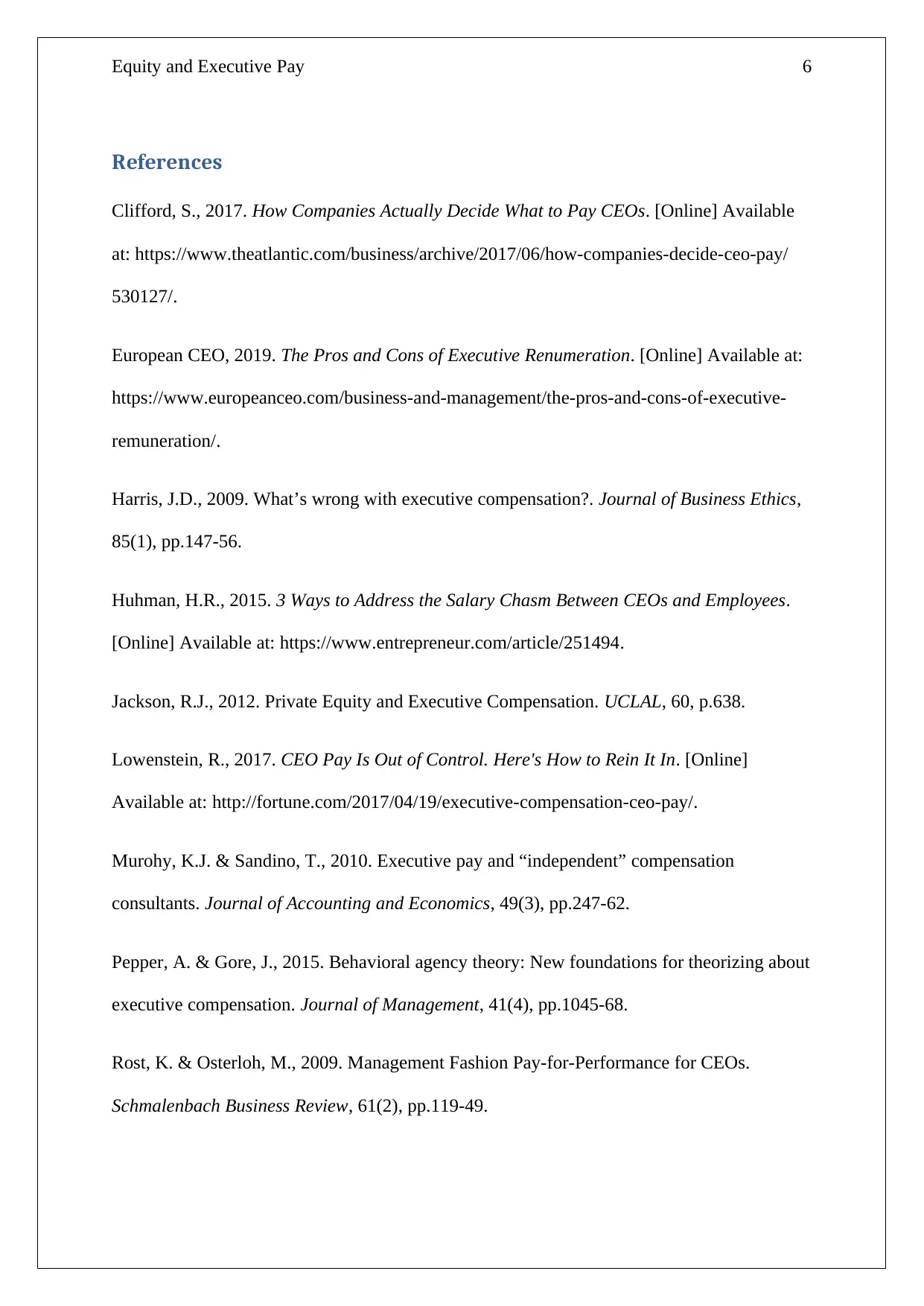
Equity and Executive Pay 6
References
Clifford, S., 2017. How Companies Actually Decide What to Pay CEOs. [Online] Available
at: https://www.theatlantic.com/business/archive/2017/06/how-companies-decide-ceo-pay/
530127/.
European CEO, 2019. The Pros and Cons of Executive Renumeration. [Online] Available at:
https://www.europeanceo.com/business-and-management/the-pros-and-cons-of-executive-
remuneration/.
Harris, J.D., 2009. What’s wrong with executive compensation?. Journal of Business Ethics,
85(1), pp.147-56.
Huhman, H.R., 2015. 3 Ways to Address the Salary Chasm Between CEOs and Employees.
[Online] Available at: https://www.entrepreneur.com/article/251494.
Jackson, R.J., 2012. Private Equity and Executive Compensation. UCLAL, 60, p.638.
Lowenstein, R., 2017. CEO Pay Is Out of Control. Here's How to Rein It In. [Online]
Available at: http://fortune.com/2017/04/19/executive-compensation-ceo-pay/.
Murohy, K.J. & Sandino, T., 2010. Executive pay and “independent” compensation
consultants. Journal of Accounting and Economics, 49(3), pp.247-62.
Pepper, A. & Gore, J., 2015. Behavioral agency theory: New foundations for theorizing about
executive compensation. Journal of Management, 41(4), pp.1045-68.
Rost, K. & Osterloh, M., 2009. Management Fashion Pay-for-Performance for CEOs.
Schmalenbach Business Review, 61(2), pp.119-49.
References
Clifford, S., 2017. How Companies Actually Decide What to Pay CEOs. [Online] Available
at: https://www.theatlantic.com/business/archive/2017/06/how-companies-decide-ceo-pay/
530127/.
European CEO, 2019. The Pros and Cons of Executive Renumeration. [Online] Available at:
https://www.europeanceo.com/business-and-management/the-pros-and-cons-of-executive-
remuneration/.
Harris, J.D., 2009. What’s wrong with executive compensation?. Journal of Business Ethics,
85(1), pp.147-56.
Huhman, H.R., 2015. 3 Ways to Address the Salary Chasm Between CEOs and Employees.
[Online] Available at: https://www.entrepreneur.com/article/251494.
Jackson, R.J., 2012. Private Equity and Executive Compensation. UCLAL, 60, p.638.
Lowenstein, R., 2017. CEO Pay Is Out of Control. Here's How to Rein It In. [Online]
Available at: http://fortune.com/2017/04/19/executive-compensation-ceo-pay/.
Murohy, K.J. & Sandino, T., 2010. Executive pay and “independent” compensation
consultants. Journal of Accounting and Economics, 49(3), pp.247-62.
Pepper, A. & Gore, J., 2015. Behavioral agency theory: New foundations for theorizing about
executive compensation. Journal of Management, 41(4), pp.1045-68.
Rost, K. & Osterloh, M., 2009. Management Fashion Pay-for-Performance for CEOs.
Schmalenbach Business Review, 61(2), pp.119-49.
Paraphrase This Document
Need a fresh take? Get an instant paraphrase of this document with our AI Paraphraser

Equity and Executive Pay 7
Sahni, K., 2010. Executive Compensation. [Online] Available at:
https://www.slideshare.net/kartiksahni/executive-compensation?next_slideshow=1.
Saylordotorg, 2019. CEO Performance Evaluation and Executive Compensation. [Online]
Available at: https://saylordotorg.github.io/text_corporate-governance/s10-ceo-performance-
evaluation-and.html.
Sepe, S.M., 2011. Making sense of Executive Compensation. Del. J. Corp. L., 36, p.189.
Sahni, K., 2010. Executive Compensation. [Online] Available at:
https://www.slideshare.net/kartiksahni/executive-compensation?next_slideshow=1.
Saylordotorg, 2019. CEO Performance Evaluation and Executive Compensation. [Online]
Available at: https://saylordotorg.github.io/text_corporate-governance/s10-ceo-performance-
evaluation-and.html.
Sepe, S.M., 2011. Making sense of Executive Compensation. Del. J. Corp. L., 36, p.189.
1 out of 8
Related Documents
Your All-in-One AI-Powered Toolkit for Academic Success.
+13062052269
info@desklib.com
Available 24*7 on WhatsApp / Email
![[object Object]](/_next/static/media/star-bottom.7253800d.svg)
Unlock your academic potential
Copyright © 2020–2025 A2Z Services. All Rights Reserved. Developed and managed by ZUCOL.





